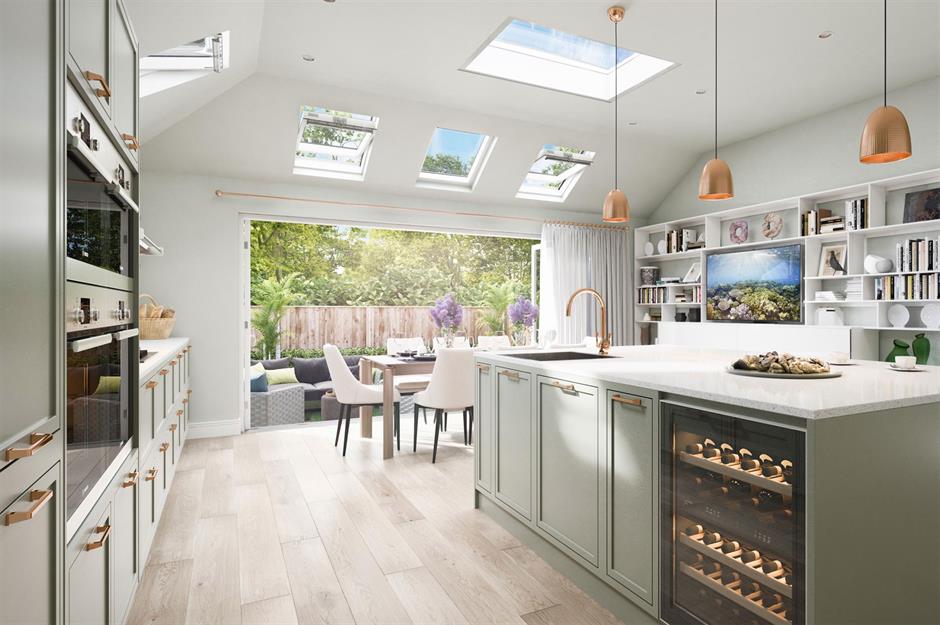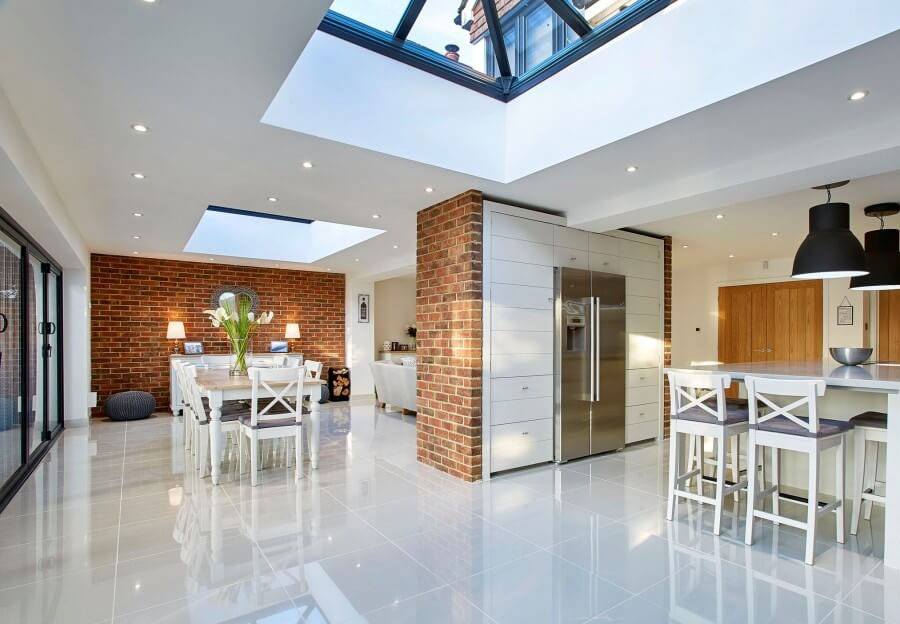Creating a relaxing, multifunctional kitchen space with a sociable and spacious layout can be achieved by an open-plan addition. Planning and executing your home extension is critical to its success. We recommend visiting a kitchen company in the Glasgow region to discuss and plan your kitchen renovations. The kitchen is the hub of the home so creating a family-friendly multifunctional space is a top priority. Open-plan kitchen layouts provide a sociable space for families and friends to spend time together. With a fluid design, the kitchen’s functionality will be good. Planning the extension with the kitchen interiors is key to having an optimal layout. Kitchen extensions will increase the value of your home if you want to sell it on and will give you more living and cooking space for you and your family to enjoy. Your kitchen designer will lead you through the process and best advise you on the various elements of your kitchen design. There are several steps you can take, that will be discussed below, that will make the renovation process smoother.
Planning your extension build
You will need to decide on what your extension will entail and the kitchen, a space to eat, whether you would like a living area, a desk space, additional storage or access to the garden. Secondly, consider what you want it to look like inside and what form of extension would suit your property. For instance, consider a single- or double-storey extension, a lean-to, a side return or rear addition. It’s a good idea to keep clippings from magazines, and to look online to see what has been built in your area to inspire you. You will need to check with the kitchen company you are using in Glasgow if you need planning permission or if it will be under permitted development.
Deciding on your extension type
Lean-tos and side returns normally need less foundation work as well as garden space, but may require more internal structural work like removing walls, disguising pillars or levelling floor and ceiling spaces. Once you have in mind the estimated idea of the size and type of extension you will be carrying out, a schedule will be needed. Time to submit planning applications, and wall agreements with neighbours if necessary as well as construction time, which takes between three and six months.
Using a kitchen company to carry out your extension
Hiring a kitchen company to carry out your extension is a good idea. The kitchen designer will ensure that your plumbing and electrical work is attended to and that your plans are structurally sound. Select your kitchen company in the Glasgow area in the planning stage so they can advise on your lighting, extraction, and zoning in your new kitchen space. The layout of your kitchen is based on your personal needs, you may want to position your cabinetry and worktops so you can enjoy a view of the garden or organise it so you can socialise with family while you’re cooking.
Set a budget for your kitchen renovations
Expenditure varies per project but the average amount is around £25,000, with a square metre price of £1,050-£1,450 set aside for a basic extension and £1,450-£1,850 for high-end renovations.Two-storey extensions may work out to be less expensive in price per square metre. The cost of a basement conversion will be greater if the space requires tanking, a drainage pump or underpinning.Remodelling a current extension may not work out cheaper than starting from the beginning, so seek advice from your kitchen designer.
The design elements of your kitchen
The kitchen company you have chosen to do your renovations will suggest a programme of works, costings and the ideas for the extension. Forward planning and getting the design work done at the beginning means the chance of late alterations, like moving windows and doors will be avoided. The aesthetics and layout of your kitchen will affect its look and functionality. Your space mustn’t look divided or too cluttered on the worktops. At the planning phase of your storage areas, remember you need to store your electronic appliances, homework books and children’s games. Your sink area will be more messy so keep that out of the line of sight.

Making your space multifunctional
Each kitchen’s layout is unique but there are a few standard rules for zoning in the room. Firstly, decide where you want to sit and eat and which view you want. Zones can be created for cooking, cleaning and eating and living. Their arrangement is a personal choice but good flow between the zones is needed. For instance, a seating area or breakfast bar that opens to the garden should be positioned near the doors leading outside.
Maximising the light in your kitchen
An extension will detract from some of the daylight coming into your original rooms, so it’s a good idea to supplement it. A row of roof lights or a roof lantern would work well. If you install the light sources near the back end of the extension, this will help sunlight reach the areas that are now darker than they were in the original room. Adding under-counter spots alongside task lighting will help add more light to important areas of your kitchen. The kitchen designer from the kitchen company you are using will advise on lighting tips. Full-length glass doors are a common aspect of extensions, this reduces wall space for storage though. Tall cupboards and kitchen islands have good storage capacity when compared to their footprint, it’s also wise to consider a pantry and adjacent utility room to ease storage requirements in the kitchen.
Creating a seamless flow in your kitchen
Your extension doesn’t need to be completed with the same theme as the remainder of your home, but it needs to be cohesive. If you have an open-plan kitchen design, there must be a seamless transition between the cooking and living space. If your extension uses a lot of glass it may be brighter than the rest of the house, so take this into account when choosing materials and colour schemes. Many kitchen designs make use of wood veneers and muted tones, and work well in an open plan kitchen where one room flows to another or flows from a traditional-themed house.
An extension that leads to an outside area is trendy and often completed with double-glazed doors. Place the doors leading out to the view. Bi-fold doors create a seamless link to the garden with sliding doors a better choice if they will be closed most of the time. Double glazed doors keep your home interior warm and make your home energy efficient saving on heating bills.
Adding the finishing touches to your kitchen
Your kitchen-dining area will be on show, so getting the décor right is critical. Hiding your plug points in a cupboard, or installing pop-up sockets works well, so the lines of your design are uninterrupted. Built-in appliances and a downdraft extractor fan that recesses into your worktop will make the space look more elegant and clutter-free. The materials you make use of should add flow to the space. Consider a grading in height from the kitchen to the dining area zone to wall units in the living area in one continuous run. Use the same colour for surfaces of cabinetry. Or you could add a contrasting worktop between zones to indicate separate areas. A wooden worktop to differentiate the dining area at the end of the room will work well or a stone worktop, or laminated MDF looks welcoming.
Using the various mentioned steps to create a smooth kitchen renovation process
With your kitchen designer on your side from the kitchen company you have chosen in the Glasgow area and using the above mentioned steps you are guaranteed to have a smooth renovation journey. Decide on what your extension will consist of- a space to eat, whether you would like a living area, a desk space, additional storage or access to the garden. Consider what form of extension would suit your property such as a single- or double-storey extension, a lean-to, a side return or rear addition. After you have decided on an extension style and size, planning applications will need to be submitted unless you have done so already, and wall agreements with neighbours if necessary as well as construction time which takes between three and six months. You will need to choose a kitchen company to do the design and building of your extension.
A budget will need to be laid out to plan expenditure. You will need to zone your area to make it multifunctional. Zones for cooking, cleaning, eating and living will be created. In terms of lighting, if you install the light sources near the back end of the extension this will help sunlight reach the areas that are now darker than they were in the original room. Installing under-counter spots together with task lighting will help add more light to important areas of your kitchen. An extension linked to an outside area is trendy and often done with double-glazed doors. Bi-fold doors create a link to the garden with sliding doors a better choice if they will be closed for most of the year. Hiding your plug points and built-in appliances removes clutter from the worktops and don’t detract from the lines you have created in your kitchen design. Taking these steps into account and using a kitchen company to carry out your renovations will mean you can build the kitchen extension of your dreams!


Recent Comments